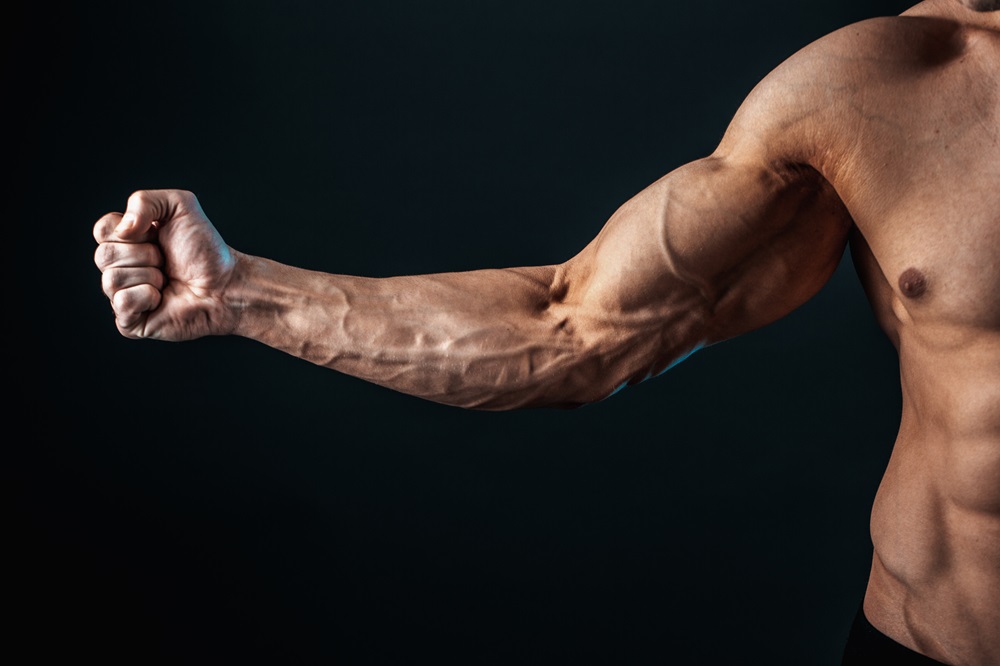Forearm Training – The Best Exercises for Strong Forearms

The forearm muscles are a small but very important muscle group. Regularly practicing forearm exercises can make everyday tasks easier, improve appearance, and help increase strength, endurance, and training efficiency. How should you prepare for forearm training? Which exercise for forearms is the most effective? What forearm exercises can you do at home?
Table of contents
Structure and functions of the forearm muscles
The forearm muscles can be divided into three groups – anterior, posterior, and lateral.
The anterior group consists of eight muscles that act as flexors: pronator teres, flexor carpi radialis, palmaris longus, flexor carpi ulnaris, flexor digitorum superficialis, flexor digitorum profundus, flexor pollicis longus, and pronator quadratus.
The lateral group includes four muscles: brachioradialis, extensor carpi radialis longus, extensor carpi radialis brevis, and supinator.
The posterior group consists of seven muscles – extensor digitorum, extensor digiti minimi, extensor carpi ulnaris, abductor pollicis longus, extensor pollicis brevis, extensor pollicis longus, and extensor indicis – which act as extensors.
The forearm muscles enable wrist rotation, wrist flexion and extension, and forearm flexion at the elbow joints. They are also responsible for flexing, adducting, and pronating the hand, as well as flexing and abducting the fingers.
Why is it worth doing forearm exercises?
Regular forearm training can bring many benefits, positively influencing not only daily functioning but also strength and training performance. Forearm exercises strengthen grip, allowing you to maintain muscle tension for longer and increasing your ability to hold weights. This can improve sports performance, especially in strength training.
Forearm exercises can also enhance overall stability, muscle efficiency, and endurance, helping you perform longer, more intense, and more demanding workouts. Improved endurance increases resistance to fatigue, while better performance – supported by strong, well-trained forearms – can help you maintain control over movements, improving safety and technique and supporting muscle mass and strength development.
Since strong forearms complement sculpted arms and shoulders, regular forearm training can also have a positive visual impact on the entire physique.
Forearm training - how to prepare?
The forearms are a small muscle group, so it’s important to be careful when training them to avoid overtraining and injuries.
To strengthen and develop the forearm muscles, you don’t necessarily need a separate workout dedicated to them. Simply adding a few forearm exercises to your routine or modifying your existing workouts so they also engage the forearms can be enough. However, forearms are a durable muscle group, and their growth requires high training volume and many repetitions.
When training forearms, keep in mind a few important aspects. Vary your elbow positions, as different angles can affect forearm strength in different ways – work in extension, full flexion, and other ranges. Because forearms adapt quickly to repeated movements, you should regularly change up your exercises to reduce injury risk and improve results. Stretching your hands and keeping the skin moisturized is also important. For experienced athletes, one-arm training can be an interesting way to diversify the routine.
Forearm muscles - exercises. The best forearm exercises
Forearm exercises can be done both at home and at the gym. You can use dumbbells, barbells, or professional training machines, but you can also train this muscle group without extra equipment, using only a pull-up bar.
Forearm training can include exercises that target the forearm muscles directly as well as supporting activities. Including a variety of forearm exercises in your plan helps activate all areas of the forearms and achieve your training goals.
Forearm exercises with dumbbells
Using dumbbells during training can boost the effectiveness of your workout, helping to strengthen your grip and develop forearm muscles. Popular dumbbell forearm exercises include:
- Overhand dumbbell curl – hold the dumbbells so the back of your hands faces upward. Let your arms hang alongside your torso, feet shoulder-width apart. Inhale, bend your elbows, and lift your forearms toward your chest, keeping your arms close to your body. After a few seconds, exhale and straighten your arms.
- Dumbbell curl with rotation – hold the dumbbells in a neutral grip with thumbs pointing downward. Stand with a slight stance, keep your back straight, and engage your abs and glutes, arms along your body. Inhale, then curl while rotating the wrists outward so that at the top, your thumbs point outward. After a few seconds, exhale and return slowly to the starting position.
- Lying forearm curl on a bench – lie on a bench with your feet on the floor. Hold the dumbbells underhand (palms up, back of hands down). Inhale and curl your forearms, engaging the biceps. After a few seconds, exhale and return to the starting position.
- Zottman curl – stand holding dumbbells in a neutral grip, arms along your sides, core and glutes tight. Inhale, curl your arms while rotating your wrists outward so your thumbs point outward at the top. Then, with elbows still bent, rotate your wrists inward so your thumbs face each other. Exhale as you slowly lower to the start.
Forearm exercises without equipment - bar training
While forearm training often uses added weight, effective forearm exercises can also be done without equipment, using only a bar and bodyweight.
- Wide-grip pull-up – grip the bar wider than shoulder width with a closed grip. Slightly bend your elbows and inhale as you pull yourself up so your chin clears the bar. Exhale as you lower yourself slowly to the starting position.
- Underhand pull-up – grip the bar underhand so the backs of your hands face down and your fingers face you. Bend your elbows and inhale as you pull yourself up until your chin is above the bar. Exhale and return to the start.
- Bar hang – grip the bar wider than shoulder width, keep your spine neutral, engage your abs and shoulder blades, and hang for several seconds with knees slightly bent. Lower yourself back down.
- Towel pull-up – an alternative that strengthens grip and improves stability. Beginners can combine the bar with a towel, draping the towel over the bar. Securely grip the towel, inhale, bend your elbows, and pull yourself up. Exhale as you return to the start.

